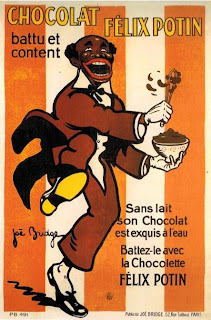The city of Paris has mounted a phenomenal, one-of-a-kind exposition called Paris en Chansons that features the celebration of the City of Light in song. The exhibition traces the history of songs about Paris since the Middle Ages. More recently, artists from Aristide Briand to Vanessa Paradis have crooned about Paris' monuments, social life, metro, and everything in between!
Among this group, black artists are few. But one of them remains larger than life: Josephine Baker.
Josephine's face graces the flier that publicizes the event. Inside the exhibit, an illustration of her by Jean Dunand and the program for her performance run in the show Paris qui Remue at the Folies Bergère are the first documents shown in the display table on the ground floor. On the lower level, where the majority of the exposition is mounted, you find numerous items that highlight Josephine's immortalization of Paris in song. Among them are the cover of the sheet music for her recording "Paris Paris Paris," the cover for her album entitled Joséphine Chante Paris, and a video of her singing "J'ai Deux Amours."
Of particular interest are the black & white photos of Josephine that were loaned to the exposition by Roget-Viollet:
© Studio Lipnitzki / Roget-Viollet
February 1949
© Studio Lipnitzki / Roget-Viollet
A third image of Josephine in the street surrounded by a band of musicians provides a rare perspective for those who think of her only as an international star. In this photo, which was taken in May 1968, she is modestly dressed and wearing heavy-framed glasses and a wig. The text accompanying the photo says that during the time she was in Paris rehearsing for a comeback performance at the Olympia Theater, she took the time to go into the streets to distribute bouquets of blue, white, and red flowers and sing the melody "Fleur de Paris."
At the end of the exposition there is an open area where visitors can peruse several books that feature many of the artists whose songs are part of the exhibit. Among these books is the recently released biography of Josephine written by her fifth adopted child, Jean-Claude Bouillon-Baker. It is called Un Château sur la Lune. Le Rêve Brisé de Josephine Baker (A Castle on the Moon. The Broken Dream of Josephine Baker). Written in French, this book undoubtedly sheds new insight into the life of Josephine and her family at Les Milandes and Josephine's career.
Two other black artists are included in this exposition. Eartha Kitt's recording of "Mambo in Paris" is one of the songs that you can listen to in the section called "Paris est une fête." Sidney Bechet's "King Porter Stomp" is one of the tracks on a compilation album called Saint Germain des Prés that is displayed in the section of the exposition that focuses on this area of the city.
Listen to Eartha Kitt's "Mambo de Paris" here (#14 in the playlist). Watch Sidney Bechet perform "King Porter Stomp" by clicking here.
The exposition ends on July 29th.
Galerie des Bibliothèques de la Ville de Paris
22, rue Malher
Paris 4e
Métro : Saint-Paul
Hours: Tuesday through Sunday 1 PM to 7 PM, Thursday evenings until 9 PM
Entry 6€; Reduced price 4€
Free for children under 14.
Half price on Thursdays from 6 to 9 PM and on Saturdays from 4 to 7 PM
************
Entrée to Black Paris!™ is a Discover Paris! blog.
If you liked this article, share it with your friends and colleagues by clicking on one or more of the social media buttons below!
If you liked this article, share it with your friends and colleagues by clicking on one or more of the social media buttons below!








